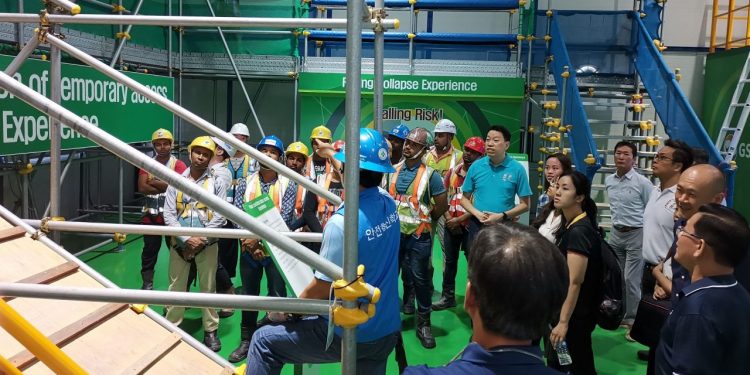This is a blog post by Labour Member of Parliament and NTUC Assistant Secretary-General Melvin Yong. Any extracts should be attributed back to the author. 30 September 2019.
Earlier today, the Ministry of Manpower (MOM) released the National Workplace Safety and Health (WSH) statistics for 1H 2019.
It is heartening to note that the number of workplace fatalities had decreased. However, the number of non-fatal workplace injuries had increased by 8 per cent from 6,073 cases in 1H 2018 to 6,561 cases in 1H 2019.
Decrease in Workplace Fatalities Simply Not Good Enough
The increase in workplace injuries is certainly a cause for concern. It begets the question – is the decrease in workplace fatalities due to luck, or perhaps medical technology is so advanced now that workers who suffered injuries which could have been fatal previously have better odds these days?
How many of the major injuries would’ve been fatal if they had happened a few years ago? We will never know.
Despite the improvements in medical technologies, every accident that happens – even the minor ones – is a danger to our workers. Inherent in every injury is the risk that it may worsen and result in a tragedy. Seemingly minor injuries at the first instance can worsen into a major injury, and a major injury can lead to death. Unfortunately, in 17 of the accidents that happened in the first half of 2019, the victims succumbed to their injuries.
Earlier this month, parliament passed the Work Injury Compensation Act (Amendments) Bill. I was heartened at the timely amendments, as it seeks to provide a faster and better way to compensate employees in the event of an unfortunate accident due to the course of their work. But more can be done. The Labour Movement stands ready to work with our tripartite partners to improve Workplace Safety and decrease the number of workplace fatalities as well as workplace injuries.

Total WSH Means Looking Beyond Just Workplace Safety
While it is important that we continue to improve Workplace Safety practices, we need to look at WSH holistically by placing equal emphasis on Workplace Health, which is the latter – and often overlooked – half of the WSH equation.
Occupational Diseases Statistics Does Not Take into Account Mental Health Issues
MOM’s statistics also show that the total number of Occupational Diseases has fallen by 11 per cent. While this is a good sign, the statistic only reflects the paradigm of today’s definition of Occupational Disease.
Our workplaces are becoming increasingly desk-bound, particularly for many of our PMEs. Studies have shown that sedentary jobs give rise to new forms of Occupational Diseases, many of which are not covered under the Work Injury and Compensation Act (WICA). For example, long working hours coupled with a stressful workplace environment can result in mental health issues such as workplace burnout, which is now a recognised occupational phenomenon by the World Health Organisation. Feeling “burnt out” is a common phrase we hear among workers, but little has been done to learn more about its longer-term health effects.
Such occupation-related mental health issues can lead and have led to negative physical health outcomes. According to a recent study by a Cigna, Singaporeans are among the most stressed at work globally, with almost one in eight considering their stress as unmanageable.
In my parliamentary speech during the debate on the Work Injury and Compensation Bill, I called on MOM to consider expanding the list of Occupational Diseases covered under WICA to include mental health issues arising from the workplace. Even if we are not ready to do so, we should at least initiate more studies on the effects of such workplace mental health issues.
Mental health issues arising from work are a real and an ever-present danger at the workplace. We can quibble about how to label such mental health issues – whether it’s an occupational phenomenon or a work-related disease. What is clear however, is that we need to protect our workers who may be suffering in silence.
Encourage Workers to Lead a Healthy Lifestyle
In order for WSH to be pervasive in every industry, companies must also embrace Total WSH and encourage their employees to lead a healthy lifestyle. For instance, those with staff canteens can provide healthier eating options, to encourage workers to take good care of their health. The canteens operated by the National Transport Workers Union (NTWU) have done exactly this through our Brown Rice campaign, which has been a big success across our 46 canteens. We have also tried to promote sugar-free drinks, such as Kopi-O kosong and Teh-O kosong. Unfortunately, this was not as successful as the brown rice initiative, but we will try again. Through constant experimentation, I believe that we will be able to find the right initiatives to encourage healthy eating among our workers. The Labour Movement stands ready to partner with companies to introduce initiatives to promote healthy eating and achieve Total WSH.

The importance of working towards Total WSH cannot be understated, as it has tangible positive health outcomes to the wellbeing of our workers. Take SATS for example, who has partnered the Air Transport Executive Staff Union (AESU) and SATS Workers Union (SATSWU) as early adopters of the Total WSH programme. As part of this programme, SATS employees were offered health screenings and subsequently health coaching sessions that followed-up on their health findings. They were also coached to correct poor work postures to lower the risk of ergonomic-related injuries at the workplace.
The results? SATS employees felt healthier and were more productive and engaged. I hope that such win-win outcomes for both employers and employees will convince the business community to place equal emphasis on Workplace Health.
Tripartite Relationship Key Towards Achieving Total WSH
Total WSH goes beyond just Workplace Safety. While we work on lowering workplace injuries, it is important that tripartite partners also come together to help those suffering from mental health issues in silence. Only by focusing equally on preventing workplace accidents, and on Workplace Health initiatives, can we truly achieve Total WSH.

